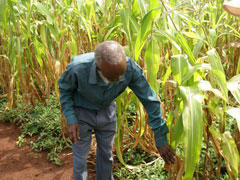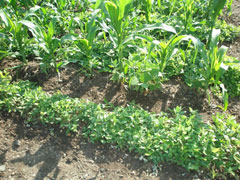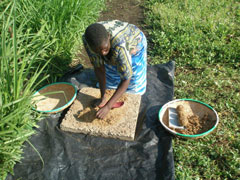
Gender issues in food and farming
Example 3. Beyond agro-chemical pest control in Ecuador to push-pull insect control in Africa
by Janice Jiggins
Human health has been badly affected not just in developing countries but also in industrial countries through application of crop protection chemicals. I'd like to give you an example from the high mountain regions of Ecuador. It’s traditionally a potato growing area and very important to agricultural science because it is the home territory of many of the important potato genetics that we need to improve the crop for potato growers around the entire world. The trouble is that, as any of you who try to grow potatoes in your back garden in your own part of the world will know, potatoes are quite susceptible to a particular pattern of disease called Blight. And in order to control this in a modern way, farmers were persuaded to begin using agrochemicals for protection. The trouble is that the more chemicals you use the more resistance builds up in the crop and in the pathogen and the more and more and more you have to use. It's often argued that this is a containable problem, if only farmers would use the chemicals in the way the companies recommend and at the dosages they think are effective, but that's not the real world and you can't put all the blame on the user. The companies have been very reluctant to admit liability for their own products in actual use.
Researchers in the Ecuador case found that not only the person who was directly applying the chemicals on the crop but all members of the community were affected in terms of their health. What they picked up was a really shocking degree of neurological damage to their health. They suffered skin rashes, impaired cognitive function, reduced ability to perform simple verbal and mathematical tests. Women, children, men, everybody, farm labourers, potato transporters, packers, everybody was affected because, as the researchers demonstrated, the chemicals had spread through the entire environment.
The means of transmission were also documented. For instance, the children picked up traces on their clothes and from the ground whilst they were playing, containerrs were reused for carrying water for washing and drinking and watering animals, the chemicals washed off the crop and entered the groundwater and into the streams, and so on. The chemicals were found to be spread through the homes on the walls, on the floor, and picked up during the food preparaiton. The trouble is, many people tend to think this is an extreme kind of case. Of course, a terrible tragedy for those involved but surely we can't destroy a whole industry simply because of extreme cases?. After all, they argue, without crop protection chemicals we would not have what we have in our supermarkets today.
Well, the thing is, there are other effective options for crop protection but companies can't make much money out of them.
Let’s take a look at the contribution of icipe, a science-based institute in Nairobi in Kenya, to many a surprising place to look for solutions. The institute was established by a far-sighted Kenyan entomologist. The current director-general is an Ethiopian woman scientist. The institute’s researchers are carrying out excellent world-class science and their mandate is to make this science work for small farmers. And, of course, one of the things that has really concerned them is this whole issue around the use of agrochemicals: was there a way that small farmers, with just a small plot of land and little cash income, could increase the productivity of maize and protect their crop?.
The researchers are specialists on everything to do with insects and their environment. And they thought, well, insects interact with each other through chemical signaling. The scientists also knew that crop plants give off particular odours. And so they asked themselves if there wasn’t a way of pushing the insects that we don't want out of a crop by attracting them to a border plant grown around a field, that smells better to the insect than the crop. And can we do something similar to pull the insects that prey on the ones that do damage, into the crop?. I am putting this push-pull strategy in very simple terms: there’s a lot of good science behind it!.
As push-pull systems have been developed and adapted to different crops and agricultural areas, icipe’s researchers found that some of the border plants that can be used, like particular varieties of Napier grass, could also be used to feed milk cows and goats. So not only could small farmers protect their crops without using agrochemicals, which small farmers can't afford, and avoid all the health and environmental consequences of their use, the strategy has begun to create new income streams and improve farmers’ health because they’re better fed from the additional milk and meat. Some farmers also are specialising in producing the seed for some of these push pull plants. What we see over time is how push-pull restores ecological complexity to small farm systems, increases production stability and adds to food security, while enabling small farms to gain new income opportunities. And that's a very good example of how to apply modern science for the benefit of small farmers and the environment.
Sherwood, S. (2009) Learning from Carchi. Agricultural Modernisation and the Production of decline. Published Ph.D thesis. Wageningen. Wageningen University. The Netherlands.
Crissman, C.C., J.M. Antle, and S.M. Capalbo (Eds.) (1998) Economic, Environmental, and Health Tradeoffs in Agriculture: Pesticides and the Sustainability of Andean Potato Production. Kluwer Academic Publishers. Dordrecht, The Netherlands.
icipe:
www.icipe.org
icipe (2013) Push-pull and gender: improving livelihoods and social equity. Nairobi. International Centre of Insect Physiology and Ecology.
icipe (2013) Climate-smart push-pull: resilient, adaptable conservation agriculture for the future. Nairobi. International Centre of Insect Physiology and Ecology.
Photos


